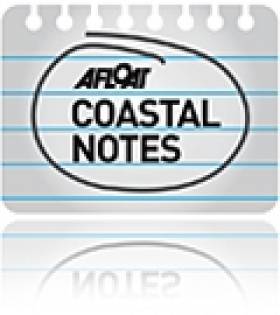Displaying items by tag: Inis Meain
In Search of Hy-Brasil Exhibition Visits Inis Meáin
In Search of Hy-Brasil, an exhibition reflecting fieldwork from Ireland’s offshore islands, has begun a nationwide tour on the Aran island of Inis Meáin.
As previously reported by Afloat, the exhibition first appeared in the Irish pavilion at last year’s Venice Biennale and is curated by a team of five architects,Elizabeth Hatz, Peter Cody, Mary Laheen, Peter Carroll and Joseph Mackey.
It responded to the theme “The Laboratory of the Future – selected by curator of the Biennale Architettura 2023, Lesley Lokko.
Dutch interior designers Hanneke Frenkel’s sea mats and sacks created from her beachcombing on Turbot island west of Clifden formed part of the exhibition.
An abstraction of Sceilg Mhichíl (Skellig Michael) off the Kerry coast made from Galway sheep’s wool, and results of Mayo’s Clare Island Survey were also selected.
The curators have studied the island landscapes of Inis Meáin, UNESCO World Heritage site Sceilg Mhicíl (Skellig Michael) and Cliara (Clare Island) through drawing, survey, film, sound, model, mapping, and story.
The installation aims to offer an immersive experience that draws connections between the social fabric, cultural landscape and ecology of these islands, shifting between the global and the local, the territorial and the intimate.
The exhibition tour is supported by the Arts Council, and opened on Inis Meáín late last week as part of “Island Conversations” at Coláiste Naomh Eoin Secondary School.
It moves from Inis Meáín to the Solstice Arts Centre in Navan, Co Meath from June 22nd to August 31st, and at the Architecture at the Edge festival in Galway from September 20th to October 8th.
RTE News has more on the story here
Photographer's Depiction of Inis Meáin Across a Half Century Due To Be Broadcast on TG4
A photographer’s depiction of the passage of time on an Irish offshore island is captured in a television documentary due to be broadcast on TG4 on Thursday (Dec 28)
Fifty years ago, photographer Chris Rodmell “captured the soul” of the Aran island of Inis Meáin, which was “a place poised at the edge of transformation” and “untouched by modernity”, according to the TG4 billing.
Rodmell recently returned to record a second chapter and found that certain traditions have remained steadfast in that intervening period - such as the “age-old practice of herding cattle to pasture, Saint John's Day bonfires piercing the night sky, mainland children flocking to local schools to learn Irish and the resurrection of the delicate art of knitting”.
"Inis Meáin: Idir Dhá Linn" is billed by TG4 as “a captivating television documentary that takes audiences on an emotional journey to a secluded island nestled on the western fringes of Europe”.
Cathal Ó Cuaig directed the documentary produced by Aniar TV for TG4; it will be broadcast on TG4 on Thursday, December 28th at 9.20 pm.
Two Families to Live Rent-Free for School Year on Inis Meáin
Families from Co Meath and Co Limerick will be housed rent-free in the Aran Islands as part of a drive to boost the number of school children locally.
The two families were chosen from more than 1,600 people — including some from as far away as Canada and even Australia — who applied for the scheme devised by Inis Meáin’s development body, as TheJournal.ie reports.
Two homes were sourced on the island for the nine months of the school year for the successful families, who can avail of local supports for remote working and whose children will attend school through Irish in the Gaeltacht area.
TheJournal.ie has much more on the story HERE.
Economic Development of the Islands – Minister Launches Report
The Minister for Community, Equality and Gaeltacht Affairs, Pat Carey, T.D., has announced the launch of a report on the employment needs and the economic development potential of the islands. The economic consultants, FGS Consulting, were commissioned by the Department of Community, Equality and Gaeltacht Affairs to compile the report under the direction of a steering committee made up of representatives from Comhar na nOileán, Údarás na Gaeltachta and the Department itself. The report's recommendations relate to the following areas:
- Issues related to the cost of living and to improving the islands' infrastructure;
- Cost factors that prevent the establishment and operation of commercial enterprises on the islands;
- The islands' development potential and the employment needs of island communities;
- Recommendations regarding further targeted support measures which would be aimed at the promotion of sustainable development and job creation; and
- The costs and advantages relating to any of the new measures recommended to support investment.
Minister Carey said that the Department would use the report as a basis for the development of further policies in relation to the islands in the coming years and that he hoped that some of the recommendations could be put in place in the short term at very little cost. He said, "We now intend to carry out a further examination of the various recommendations made in the report in consultation with other relevant Departments and state agencies to establish the most practical method of implementation."
A copy of the complete study is available on the Department's website www.pobail.ie.
Further Information:
The following is a list of the islands which were included in the study:
Island County Population
Toraigh Donegal 142
Árainn Mhór Donegal 522
Clare Island Mayo 136
Inishturk Island Mayo 58
Inishbofin Galway 199
Árainn Galway 824
Inis Meáin Galway 154
Inis Oírr Galway 247
Bear Island Cork 187
Sherkin Island Cork 106
Cléire Cork 125





























































